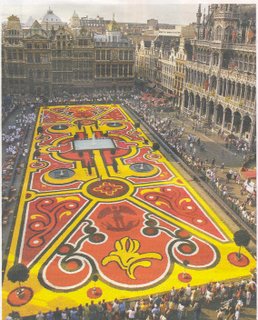Christopher Stocks reports in The Independent on Sunday ( 6 August 2006) about the Belgian city of Brussels' annual floral carpet. This year from 12 to 15 August the city's famous Grand Palace, which is a UNESECO World Heritage site, plays host to a floral carpet which will be 77m by 24m and will include something like 300,000 begonia blooms, each of which will have been hand-stuffed into place by a team of 100 expertly trained gardeners. The carpet takes just four hours to complete. The carpet has always always been intended to be seen from a distance.
The creator of the Grand Palace carpet, according to Stocks, was a begonia-loving landscape architect Etienne Stautemans. He started making small floral carpets out of begonias in the 1950s. Sadly, he died in 1998, but since then the Brussels carpets have been designed by fellow landscape architect Mark Schauttet. Each design takes the best part of a year from planning to execution, with a different theme each time: in 1981, for example, the carpet illustrated the Belgian coat of arms in honour of the state's 150th anniversary and in 1994, it was dedicated to to the British regiments that liberated Brussels from the Germans, with their regimental badges recreated entirely in begonias.
This year's theme is compared by the organisers to the stained glass of cathedral rose-windows, "a giant kaleidoscope" and "the alchemy of the Middle Ages". To Christopher Stocks, " the patterns look like Islamic tiles or Indian fretwork screens coloured in with fluorescent felttip pens, but whatever the inspiration, it's certainly an eye-catching design.
In addition to the usual complexities of design, logistics and execution, Schauttet and his team 'begoniasts' have come up with a way of mechanising the nine sections of the overall design so that each, individually, rotates on its axis, thus- presumably the comparison with a kaleidoscope, according to Stocks.



